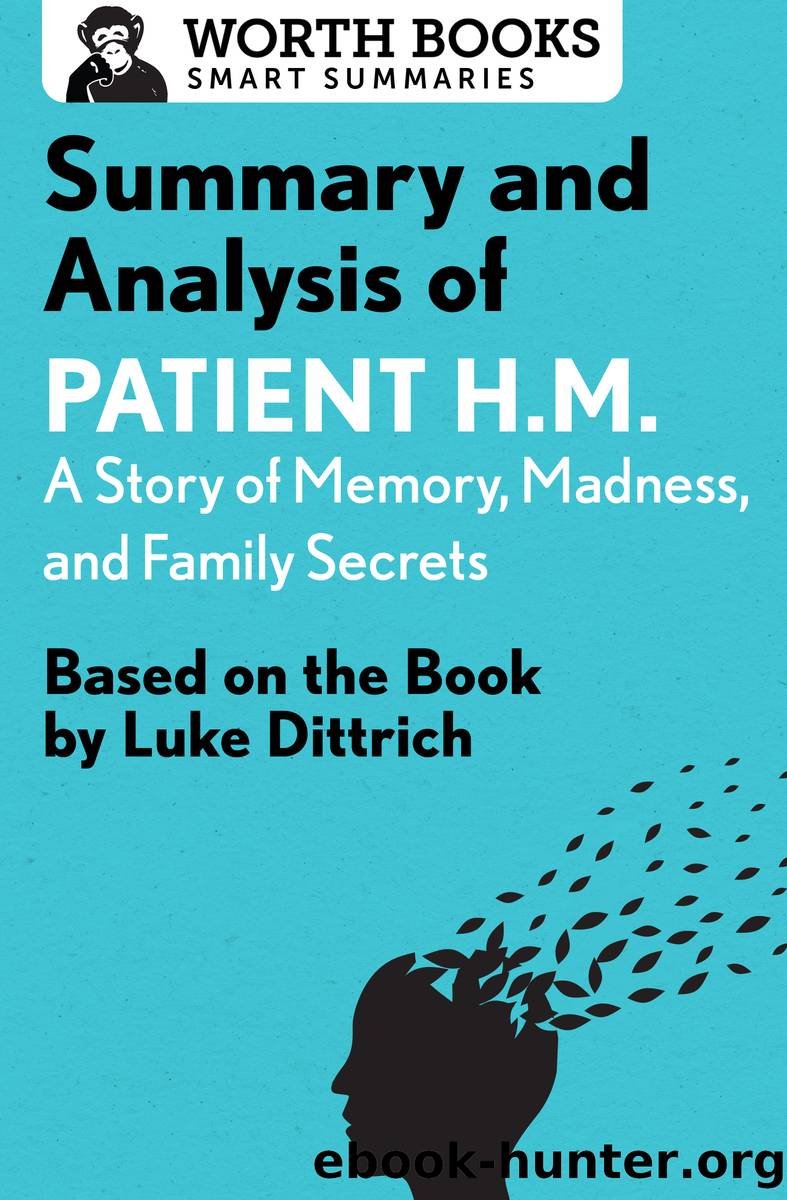Summary and Analysis of Patient H.M. by Worth Books

Author:Worth Books
Language: eng
Format: epub
Publisher: Worth Books
Published: 2017-05-09T14:19:26+00:00
PART V: SECRET WARS
Twenty-Five: Dewey Defeats Truman
As research on Henryâs unique brand of memory loss became known, neuroscientists from around the country came to interview him and to publish their findings, which were often in conflict with one another. Over the years, as Dittrich says repeatedly, Henry was studied âmore than any other human research subject in history.â
This chapter contains sections of the transcripts of those interviews, which reveal Henryâs difficulty in expressing himself and his retention of names and facts that he is unable to connect to events. For instance, in a 1970 interview, he remembers who Elvis Presley and John F. Kennedy are, but believes Elvis was in the car with the president when he was killed. This incoherent jumble of memories, along with a constant repetition of a few themes, contrast with Henryâs uncompromised native intelligence, as revealed in IQ tests.
Need to Know: All the research performed on Henry over the years did not lead to any findings more significant than those reached by Brenda Milner after her first encounters with him in the 1950s. She concluded that facts and temporal events were stored in two different areas in the human brain and that damage to one did not necessarily affect the other.
Twenty-Six: A Sweet, Tractable Man
Academic researchers described Henry as an affable, endlessly cooperative subject, a portrait that contrasts sharply with the facts of his relationship with his mother and his behavior while institutionalized. In 1974, family friend Lillian Herrick found Henryâs mother in a state of dementia on her living room floor; Henry himself was sitting nearby, apparently oblivious to her situation. Herrick moved the pair to her home, where they fought constantly, with Henry often kicking or slapping his mother. In 1980, with his mother and Herrick both dead, Henry entered a nursing home, where he had occasional outbursts, in one instance serious enough for the police to be called.
Need to Know: In this chapter, Dittrich again challenges Dr. Suzanne Corkinâs research on Henry. Dittrich says she consistently described him as having a sunny disposition, even though in tests she administered, he responded in the affirmative when asked if he felt âenragedâ or âterrified,â or if he feared being punished.
Twenty-Seven: It Is Necessary to Go to Niagara to See Niagara Falls
As Henry entered the latter part of his life, he took up residence in the Bickford Health Care Center, a nursing home. Apart from his amnesia, he was plagued by a series of ailments, including tinnitus (a constant ringing in his ears) and dementia. He also suffered a series of accidents and eventually became wheelchair-bound. Although decrepit, Henry still held out more research possibilities for Suzanne Corkin. After Lillian Herrickâs son, Thomas Mooney, was named Henryâs conservator, or legal guardian, Corkin had Mooney sign an agreement to donate Patient H.M.âs brain to MIT after his death.
Corkin consulted with surgeons and neuroanatomists as to the best ways to preserve and examine the brain. She decided that after undergoing MRI (Magnetic Resonance Imaging) scans, the brain would be dissected by Jacopo Annese, a neuroanatomist at the University of California at San Diego.
Download
This site does not store any files on its server. We only index and link to content provided by other sites. Please contact the content providers to delete copyright contents if any and email us, we'll remove relevant links or contents immediately.
Psychiatry and Racial Liberalism in Harlem, 1936-1968 by Dennis A. Doyle(121)
The Daly Dish Bold Food Made Good by Daly Gina;Daly Karol;(101)
Doctors of Deception : What They Don't Want You to Know About Shock Treatment by Linda Andre(101)
The Stem Cell Hope by Alice Park(91)
The Cure for Women by Lydia Reeder(91)
How Not to Study a Disease by Karl Herrup(89)
Doctoring Freedom by Gretchen Long(89)
Pharmaceutical Medicine and Translational Clinical Research by Vohora Divya;Singh Gursharan; & Gursharan Singh(89)
9781836207139 by Miguel Gonzalez(87)
Tissue Engineering: Principles and Practices by Fisher John P(86)
How We Became Sensorimotor: Movement, Measurement, Sensation by Mark Paterson(83)
Proper People: Early Asylum Life in the Words of Those Who Were There by David Scrimgeour(83)
A Secret Mind by Kaye Kelly(82)
Medical Applications of Beta-Glucan by Gürünlü Betül;(76)
Summary and Analysis of Patient H.M. by Worth Books(72)
Mary Putnam Jacobi and the Politics of Medicine in Nineteenth-Century America by Carla Bittel(72)
Women Doctors in War by Judith Bellafaire; Mercedes Herrera Graf(71)
The Changing Face of Medicine : Women Doctors and the Evolution of Health Care in America by Ann K. Boulis; Jerry A. Jacobs(70)
Mixing Medicines by Griffin Clare;(67)
